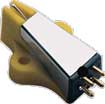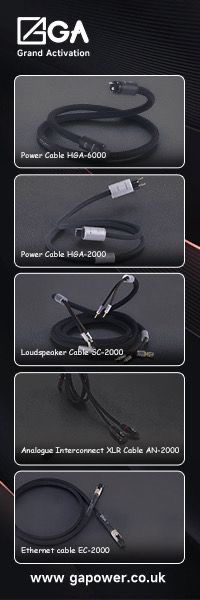The Rega Exact Phono Cartridge
| The Rega Exact Phono Cartridge |
|
An Overlooked Gem |
|
Paul Szabady |
|
2 February 2003 |
Specifications
 Fixed-Stylus Moving Magnet Phono Cartridge.
Fixed-Stylus Moving Magnet Phono Cartridge.
Vital fine-line stylus
Output: 6.8 -7.2 mV
Tracking weight: 1.75 g
Rega 3-Point mounting.
Price: $595
Address:
Rega Research Limited
119 Park Street
Westcliff-on-Sea
Essex, England SS0 7PD
Website: www.rega.co.uk/index2.htm
Email: service@rega.co.uk
US Distributor:
Lauerman Audio Import
Steve Lauerman
PO Box 3424
Knoxville TN 37927
Telephone: 865-521-6464
Fax: 865-521-9494
Email: realhifi@aol.com
The moving coil cartridge has so dominated the attention of analogue enthusiasts that it has become orthodoxy to consider it the only viable choice for high performance LP playback. Consider Rega Research. Dominant in both consumer and OEM tonearm production and the only company to invest heavily in tonearm mass-manufacturing technology when CD was taking over in the 80’s, the UK company rules the roost when it comes to affordable yet highly musical turntables and tonearms. Rega has been guided by Roy Gandy’s unique vision and design principles: no advertising, marketing based on word of mouth, and simple, reliable and extremely musicalproducts. Yet Rega’s top-of-the-line Exact is a moving magnet cartridge.
The Exact is built by Rega rather than sourced from a larger OEM cartridge producer. It features hand-wound coils, a rigid one-piece body, a fine-line Vital non-detachable stylus and Rega’s 3-bolt mounting platform. The guiding performance model is that of rigidity and fast transmission of non-signal related mechanical vibrations away from the record/stylus interface. The job of the tonearm is to hold the cartridge still so that groove modulations can cause the relative displacement of the stylus necessary to accurately generate the signal. Eliminating the non-signal related energy generated in record playback is of utmost importance to keep the signal as pure as possible. Rega’s aim is to keep all the musical information intact by stopping loss through loose stylus mounting and resonant cartridge body material, and by rigidly connecting the cartridge to the arm, producing a resonance path away from the record, up through the arm and bearings to be finally terminated in the table’s plinth. The wheat is thus separated from the chaff.
The Exact’s 3-point bolt mounting requires a third hole on top of the headshell to use. Obviously, it mates with all of Rega’s arms and with arms that have a similar headshell design (the Origin Live Silver and Encounter being two.) Rega takes the 3-point mounting principle very seriously and even offers a torque wrench to optimize the tension on these 3 bolts. The Exact cartridge is short in height and requires a parallel-to-the-record surface VTA, so some arms might be precluded if they don’t allow the necessary clearance below the arm. Careful dressing of the headshell leads proved necessary with the Origin Live Silver and Encounter arms, for example, to keep them from fouling the record surface. A removable stylus guard cannot be used after the cartridge is mounted.
The 3-point mounting eliminates fore and aft movement of the cartridge in the headshell, thus placing overhang and tangency alignment on the accuracy of the arm pillar mounting hole distance. When set-up on a Rega table or with an armhole the same distance, the 2-null alignment of my 3 protractors shows the stylus overhang seriously short of ideal, though it is centered with Rega’s supplied protractor. Rega holds that there is no ONE perfect and correct alignment set-up for pivoted arms: all are compromises with various trade-offs. I personally have been using the 2-null alignment (combining stylus to arm pivot-point distance, headshell offset, and 2 zero-distortion null points) for 25 years and have seen nothing to contradict this procedure. Hence, Rega’s alignment immediately struck me as fishy. Auditioning the cartridge on a Rega P25 aligned according to the Rega protractor showed no obvious anomalies that I could unequivocally trace to overhang error. Removing the third mounting bolt to allow use of the 2-null alignment introduced 2 variables into the test and so rendered it meaningless. There was a noted diminution of tightness and dynamics when the 3rd mounting bolt was not used. I used the conventional 2-null alignment and 3-bolt attachment on all my test arms and tables (these allowed moving the arm hole slightly.)
The Exact’s output is a hefty 6.8-7.2 mV. I’ve long found that cartridges whose outputs are relatively high in relation to the phono stage’s input sensitivity tend to produce more forceful dynamics and drive compared to outputs that just barely drive the phono stage. The Exact’s high output also indicates better signal-to noise ratios with tube phono stages and older solid-state designs. The only concern is that the phono stage have sufficient headroom to keep it from overloading.
The immediate perception of the Exact is of immense dynamic and rhythmic drive with exceptional portrayal of timing and dynamic phrasing. Rhythm-driven music was superbly rendered: drums, bass and cymbals equally clear and articulate. I defy anyone not to get up and dance or play air drums, air bass, or air maraccas when listening to the Exact. Perceived frequency response was flat with each frequency band in equal proportion, and without any dips designed to flatter inept recordings. The Vital stylus tracked well with excellent transient response on cymbals and other high frequency percussion instruments, producing an overall clarity and control. Rock, jazz, funk, R&B, reggae and other rhythm-based musics were superbly conveyed, but acoustic and orchestral musics were not slighted. The Exact’s excellent retrieval of subtle changes in dynamics, articulate phrasing, and coherent conveyance of the overall flow of musical line, rhythmically, harmonically and melodically, is as involving and arresting as the best cartridges. Call and response, building and relief of tension, crescendo/diminuendo, in short, all the techniques of musical communication were effectively transmitted. This is all very much in the Rega tradition of getting the music right.
Listening to the Exact was thus extremely musically involving: I was more interested in the content of the music than in its more superficial minutiae. The Exact has a way of extracting the heart of a musical performance without focusing attention on the artifacts of LP playback: one critically judges the quality of the music rather than the quality of the sound, the recording or the pressing. Moreover, the cartridge was planned to produce this effect: the Rega product line is carefully auditioned during development until it produces the targeted musical effect. I only wish more companies focused on the music rather than on producing audiophile jollies.
Stereo placement of instruments was stable and believable, though stereophony fell short of stereoscopy on orchestral material. Visually hallucinatory soundstaging is not the highest priority for me, especially if attaining it involves a compromise in musical communication. Studio-produced multi-mic’ed recordings have an artificial stereo image at best and components that spotlight that falseness puncture the illusion rather than allow it to work. Simply-mic’ed orchestral recordings that attempt to produce a ‘natural’ perspective similar to that heard live do not possess the visual hallucination so favored by some audio enthusiasts. I have no objection to making the stereo image supra-real to make up for the fact that we don’t have our eyes available to locate instruments concretely as in a live performance, but I don’t consider it the ultimate priority. I laud Rega’s decision in this trade-off: an intense visual hallucination of an instrument playing is worthless if you can’t tell what it’s playing.
Timbre of instruments was well balanced, sounding neither harmonically thin nor falsely fat. Considering the Exact’s strong drive and excitement levels, it never went bright or harsh, a considerable achievement in my book. Overall I found myself consistently listening and responding to the music, my audio-critical faculties at bay.
I rank the Exact among my ‘Music Master’ cartridges: cartridges that you listen to for deep musical satisfaction. To deliver its best, it should be matched with components that are also highly adept at communicating music. Very highly recommended.
![]()
Don’t forget to bookmark us! (CTRL-SHFT-D)
Stereo Times Masthead
Publisher/Founder
Clement Perry
Editor
Dave Thomas
Senior Editors
Frank Alles, Mike Girardi, Russell Lichter, Terry London, Moreno Mitchell, Paul Szabady, Bill Wells, Mike Wright, and Stephen Yan,
Current Contributors
David Abramson, Tim Barrall, Dave Allison, Ron Cook, Lewis Dardick, John Hoffman, Dan Secula, Don Shaulis, Greg Simmons, Eric Teh, Greg Voth, Richard Willie, Ed Van Winkle, Rob Dockery, Richard Doron, and Daveed Turek
Site Management Clement Perry
Ad Designer: Martin Perry





Be the first to comment on: The Rega Exact Phono Cartridge